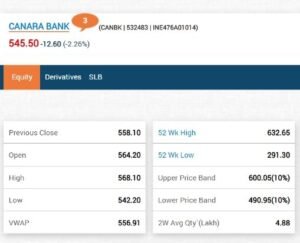Canara Bank showcased their consolidated financial results for the year end and Q4 on May 8. The company also revealed their recommended Dividend to be Rs.16.10 per share.
Net profit and growth
Canara Bank, a government-owned lender, announced a notable 18.4 percent increase in its net profit to Rs 3,757.23 crore for the fourth quarter of the financial year 2023-24. Sequentially, there was a 2.8 percent rise in net profit.
The bank attributed the rise in net profit to improved asset quality and an increase in net interest income during the reporting quarter.
In terms of asset quality, Canara Bank showed positive trends. The gross non-performing asset (NPA) ratio improved to 4.23 percent in the reporting quarter, compared to 4.39 percent in the previous quarter and 5.35 percent in the same period last year.
 Similarly, the net NPA ratio stood at 1.27 percent as of March 31, down from 1.32 percent in the previous quarter and 1.73 percent in the corresponding period last year.
Similarly, the net NPA ratio stood at 1.27 percent as of March 31, down from 1.32 percent in the previous quarter and 1.73 percent in the corresponding period last year.
According to the investor presentation, Canara Bank experienced a decline of 112 basis points in gross non-performing assets (NPA) on a year-on-year basis, while net NPA decreased by 46 basis points during the January-March quarter.
However, the bank saw an increase in fresh slippages during the reporting quarter, rising to Rs 3,082 crore from Rs 2,857 crore in the same period last year.
The Provision Coverage Ratio (PCR) as of March 31, 2024, stood at 89.10 percent, showing a slight improvement from 89.01 percent in the previous quarter and 87.31 percent in the corresponding period last year.
According to the investor presentation, Canara Bank observed a reduction in Special Mention Accounts (SMA) 2 loans valued at Rs 5 crore and above, which decreased to Rs 3,897 crore as of March 31 compared to Rs 4,516 crore in the previous quarter. However, there was a notable increase in these loans compared to the same period last year when they stood at Rs 1,880 crore.
Canara Bank Net Interest Income
In terms of Net Interest Income (NII) and Net Interest Margins (NIM), the bank experienced positive growth. NII for the January-March quarter amounted to Rs 9,580 crore, marking an 11.18 percent increase from the same period last year. NIM stood at 3.07 percent as of March 31, 2024, showing a slight increase from both the previous quarter and the same period last year.
The bank’s Global Business, including deposits and advances, grew by 11.31 percent year-on-year to Rs 2.28 lakh crore as of March 31, 2024. Domestic deposits reached Rs 1.31 lakh crore, increasing by 11.29 percent year-on-year, while domestic advances reached Rs 9.60 lakh crore, up by 11.34 percent year-on-year.
In terms of specific lending portfolios, retail lending increased by 11.68 percent year-on-year to Rs 1.56 lakh crore, and the housing loan portfolio grew by 10.81 percent year-on-year to Rs 93,482 crore. Advances to Agriculture & Allied also saw significant growth, increasing by 18.69 percent year-on-year to Rs 2.53 lakh crore.
For the financial year 2024-25, Canara Bank has set a guidance of 10 percent for Global Advances Growth and 9 percent for Global Deposits Growth. Additionally, it aims for a Gross NPA of 3.50 percent and Net NPA of 1.10 percent for FY25.
Reasons for Canara Bank’s Profit Increase (Q4 FY24):
 Canara Bank’s profit rise can be attributed to a combination of factors:
Canara Bank’s profit rise can be attributed to a combination of factors:
-
Improved Asset Quality:
- NPA (Non-Performing Assets) ratio decreased year-on-year, indicating better loan management and fewer defaults.
- Provision Coverage Ratio (PCR) improved slightly, suggesting stronger buffers against potential loan losses.
- Reduction in Special Mention Accounts (SMA) 2 loans, a positive sign for early identification and resolution of potential problems.
-
Increased Net Interest Income (NII):
- Growth in both domestic deposits and advances led to higher interest income.
- NIM (Net Interest Margin) also showed a slight increase, indicating efficiency in managing interest rates on loans and deposits.
-
Growth in Specific Lending Segments:
- Rise in retail lending, housing loans, and advances to Agriculture & Allied sectors signifies broader loan portfolio diversification and potentially higher returns.
However, some factors require attention:
- Increase in Fresh Slippages: Despite lower NPAs, a rise in fresh slippages (loans turning bad) during the quarter needs monitoring.
Overall, Canara Bank’s profit growth reflects a combination of improved asset quality, strategic lending growth, and efficient interest rate management. However, they should continue monitoring fresh slippages to ensure NPA reduction continues in the long run.











Comments 2